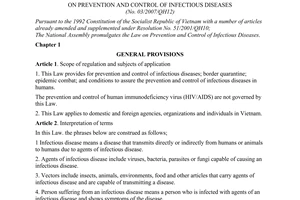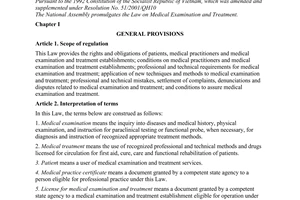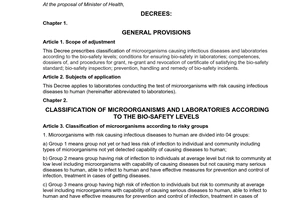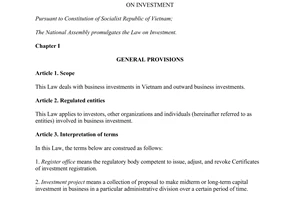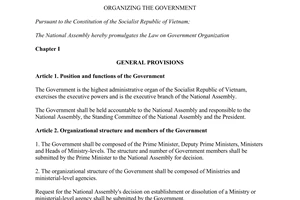Nội dung toàn văn Decree 103/2016/NĐ-CP biosafety laboratories
|
THE
GOVERNMENT |
SOCIALIST
REPUBLIC OF VIETNAM |
|
No. 103/2016/NĐ-CP |
Ha Noi, July 01, 2016 |
DECREE
ON BIOSAFETY IN LABORATORIES
Pursuant to the Law on Government organization dated June 19, 2015;
Pursuant to the Law on prevention and control of infectious diseases dated November 21, 2007;
Pursuant to the Law on investment dated November 26, 2014;
At the request of the Minister of Health;
The Government hereby promulgates the Decree on biosafety in laboratories.
Chapter I
GENERAL PROVISIONS
Article 1. Scope of regulation
This Decree provides for the conditions for ensuring biosafety at facilities with laboratories studying microorganisms with risk of causing infectious diseases to human and pathology specimens likely to carry microorganisms with risk of causing infectious diseases to organizations and/or individuals (hereinafter referred to as testing facilities), including: classification of microorganisms causing infectious diseases and testing facilities according to biosafety levels; conditions for ensuring biosafety in laboratories; competence, documents, procedures for issuance, reissuance and revocation of the Certificate of satisfaction of biosafety standards and declaration of laboratories satisfying biosafety standards; biosafety testing; prevention, handling and remedy for bisafety incidents.
Article 2. Conditions for operation of facilities providing infectious microorganism testing services
Any facility providing infectious microorganism testing services must:
1. Be legally established according to laws; and
2. Have laboratories satisfying the requirements specified in this Decree. If the infectious microorganism testing services provider is a healthcare facility, then apart from fulfillment of requirements specified in this Decree, such facility must comply with regulations in the Law on Medical examination and treatment.
Chapter II
CLASSIFICATION OF MICROORGANISMS AND TESTING FACILITIES ACCORDING TO BIOSAFETY LEVELS
Article 3. Classification of microorganisms according to risky category
1. Microorganisms are organisms with very small size that cannot be seen by naked eyes but by microscopes, including prion, viruses, germs, parasites and mycotoxins. Microorganisms with risk of causing infectious diseases to human are divided into 04 groups:
a) Group 1 means group of microorganisms which have not yet or have less risk of infection to individuals and community including types of microorganisms not yet detected capability of causing diseases to human;
b) Group 2 means group of microorganisms having risk of infection to individuals at an average level but their risk to the community is at a low level, including microorganisms with capability of causing diseases but not causing many serious diseases to human, able to infect human and effective measures for prevention and treatment for the infection are available;
c) Group 3 means group of microorganisms having high risk of infection to individuals but their risk to the community is at an average level, including microorganisms with capability of causing serious diseases to human, able to infect human and effective measures for prevention and treatment for the infection are available;
d) Group 4 means group of microorganisms having high risk of infection to individuals and the community, including microorganisms with capability of causing serious diseases to human, able to infect human and not any effective measure for prevention and treatment for the infection is available;
2. The Minister of Health shall specify the list of microorganisms causing infectious diseases sorted by risky categories.
Article 4. Classification of testing facilities according to biosafety level
1. Testing facilities are divided into 04 biosafety levels as follows:
a) Level I biosafety-testing facilities are those which are eligible to conduct tests of group 1 microorganisms specified in point a clause 1 Article 3 of this Decree and derivatives of microoganisms of other groups which have been treated and are no longer able to cause a disease;
b) Level II biosafety-testing facilities are those which are eligible to conduct tests of group 1 and group 2 microorganisms specified in point a and point b clause 1 Article 3 of this Decree and derivatives of microoganisms of group 3 and group 4 which have been treated in accordance with conditions of the level II biosafety-testing facilities;
c) Level III biosafety-testing facilities are those which are eligible to conduct tests of group 1, group 2 and group 3 microorganisms specified in point a, point b and point c clause 1 Article 3 of this Decree and derivatives of microoganisms of group 4 which have been treated in accordance with conditions of the level III biosafety-testing facilities;
d) Level IV biosafety-testing facilities are those which are eligible to conduct tests of 4 groups of microorganisms specified in Article 3 of this Decree.
2. The Minister of Health shall specify biosafety levels in accordance with the testing techniques.
Chapter III
REQUIREMENTS FOR ENSURING BIOSAFETY IN LABORATORIES
Article 5. Requirements for level I biosafety-testing facilities
The area of laboratories working with microorganisms with risk of causing infectious diseases to human and pathology specimens likely to carry microorganisms with risk of causing infectious diseases to human (hereinafter referred to as testing area) must fulfill the following requirements:
1. Required facilities:
a) Floors, walls and lab tables that are flat, waterproof, resistant to heat and corrosive chemicals and easy to cleanse;
b) Washbasins, emergency eye wash stations and first aid kits;
c) Electricity supply; the electricity system that is earthed and standby electricity sources;
dd) Fresh water carried directly to the testing area equipped with a backflow prevention device to protect the public water supply system;
dd) Fire safety equipment;
e) Sufficient lighting for testing activities.
2. Required equipment:
a) Testing equipment suitable for the testing technique and the pathology specimens/microorganisms undergoing the tests;
b) Wrapping, tools and devices for packaging biomedical wastes according to regulations;
c) Equipment for pasteurizing tools and specimens;
d) Personal protective equipment in accordance with the testing techniques conducted at level I biosafety-testing facilities.
3. Requirements for employees:
a) Number of employees: at least 02 test technicians. Any employee of a testing facility who directly performs the microorganism tests (hereinafter referred to as the test technician) must have qualifications suitable for the tests performed by such facility.
b) Any facility with a laboratory must assign a person in charge of the biosafety;
c) Test technician and the person in charge of the biosafety must receive training in biosafety of level I or higher;
d) Other employees working in the testing area must be provided with training in biosafety suitable for their tasks.
4. Required regulations and procedures:
a) Regulations on entrance to and exit from testing areas;
b) Regulations on reporting;
c) Document storing procedures;
d) Testing process in accordance with the technique and the pathology specimen or the microorganism undergoing the test;
dd) Guidelines on use of equipment serving the testing activities;
e) Decontamination and waste treatment process;
g) Regulations on health and healthcare supervision.
Article 6. Requirements for level II biosafety-testing facilities
The testing area must fulfill the following requirements:
1. Required facilities:
a) The facilities specified in clause 1 Article 5 of this Decree;
b) Wastewater collection and treatment system and equipment. Regarding testing facilities which have been operated before the effective date of this Decree, the wastewater testing result proving the wastewater satisfying National technical regulation on water environment must be presented before discharging such wastewater to the septic tank;
c) The laboratory must be separate from other rooms of the testing facilities;
d) There shall be a biohazard sign on the door of the testing area using the Model No. 01 in the Annex enclosed with this Decree.
2. Required equipment:
a) The equipment specified in point a and point b clause 2 Article 5 of this Decree;
b) Biosafety cabinets;
c) Infectious healthcare waste autoclave or sterilizer;
d) Personal protective equipment in accordance with the testing techniques conducted at level II biosafety-testing facilities.
3. Requirements for employees:
a) Conditions specified in point a, point b and point d clause 3 Article 5 of this Decree;
b) The test technician and the person in charge of the biosafety must receive training in biosafety of level II or higher;
4. Required regulations and procedures:
a) Regulations and procedures specified in clause 4 Article 5 of this Decree;
b) Plans for training for employees working in testing areas;
c) Regulations on retention and storage of pathology specimens and specimens of agents of infectious diseases at testing facilities;
d) Plans for the assessment of risk of biosafety incidents at testing facilities and formulation of plans on prevention and treatment of biosafety incidents.
Article 7. Requirements for level III biosafety-testing facilities
The testing area must fulfill the following requirements:
1. Required facilities:
a) Laboratories for conducting tests and anterooms;
b) The facilities specified in point a, point b and point d clause 1 Article 6 of this Decree;
c) The laboratory must be separate from other rooms and areas of the testing facilities;
dd) The laboratory must be airtight to ensure being sterilized;
dd) Windows and doors which are made of fireproof and strength materials;
e) Door system which ensures that in normal conditions, only either the door of the anteroom or of the testing area is opened at a time;
g) Glass windows or devices for observing the inside of the laboratory from the outside;
h) Ventiation system which is designed in one-way princple; air from the testing area must go through an air filter with high filtration performance before discharging to the outside area;
i) System for alerting when the pressure of the testing area is unconformable; the pressure of the testing area must be always lower than that of the outside area when the testing area is in working order;
k) The air changes rate of the testing areas must be at least 6 times per hour;
l) The air supply system must operates only when the air discharge system has operated and must automatically stop when the air discharge system stop;
m) Bathing devices for emergencies in the testing area;
n) Two-way communication system and alert system.
2. Required equipment:
a) Conditions regarding equipment specified in point a and point b clause 2 Article 5 of this Decree;
b) Biosafety cabinet of level II or higher;
c) Infectious healthcare waste autoclave or sterilizer placed in the testing area;
d) Personal protective equipment in accordance with the testing techniques conducted at level III biosafety-testing areas.
3. Requirements for employees:
a) Number of employees: at least 02 test technicians and 01 technician in charge of operating the laboratory. Test technicians must have qualifications suitable for the tests, the technician in charge of operating the laboratory must have qualifications suitable for the task of operating the testing area;
b) Conditions specified in point b clause 3 Article 5 of this Decree;
c) Test technicians and the technicians in charge of operating the testing area and the person in charge of the biosafety must receive training in biosafety of level III or higher.
4. Required regulations and procedures:
a) Regulations and procedures specified in clause 4 Article 6 of this Decree;
b) Procedures for pasteurizing materials, tools, equipment and infectious substances before they are taken to the outside of the laboratory;
c) Procedures for sterilizing the testing area;
d) Procedures for handling emergencies in the testing area;
dd) Plans for prevention, elimination and treatment of biosafety incidents.
Article 8. Requirements for level IV biosafety-testing facilities
1. Required facilities:
a) The facitities specified in points a, b, d, dd, e, g and h clause 1 Article 7 of this Decree;
b) Changing rooms between the anteroom and the testing area;
c) Separate aperiodic ventilation system for the level III biosafety cabinet;
d) Independent system providing air for the protective clothes which are able to supply 100% more air volume in case of biosafety incidents;
dd) The laboratories must be separate and secured;
e) Specialized boxes for transporting infectious materials out and into the testing area;
g) Air supplied to and discharged from the testing area must be filtered with an air filter with high filtration performance.
2. Required equipment:
a) The equipment specified in point a and point b clause 2 Article 5 of this Decree;
b) Biosafety cabinet of level III or higher;
c) Two-door infectious healthcare waste autoclave;
d) Personal protective equipment in accordance with the testing techniques conducted at level IV biosafety-testing facilities.
3. Requirements for employees:
a) Conditions regarding employees specified in point a and point b clause 3 Article 7 of this Decree;
b) Test technicians and the technicians in charge of operating the testing area and the person in charge of the biosafety must receive training in biosafety of level IV.
4. Required regulations and procedures:
a) The regulations and procedures specified in clause 4 Article 7 of this Decree;
b) Procedures for transporting materials and tools into and out of the testing area using a transporting box or a two-door infectious healthcare waste autoclave;
c) Procedures for securing the testing area;
Article 9. Regulations on practices in biosafety-testing facilities
1. Level I, level II, level III and level IV biosafety-testing facilities must comply with the requirements for facilities, equipment, employees and practices; restoration, maintenance and calibration of testing equipment and supervision of practces in the laboratory.
2. The Minister of Health shall promulgates guilines on practices of ensuring biosafety in laboratories.
Chapter IV
POWER TO ISSUE, REISSUE, DECLARE AND REVOKE CERTIFICATES OF SATISFACTION OF BIOSAFETY STANDARDS
Article 10. Power to issue, reissue, declare and revoke certificates of satisfaction of biosafety standards
1. The Minister of Health shall conduct inspections, issue, reissue or revoke Certificates of satisfaction of biosafety standards for level III and level IV biosafety-testing facilities (hereinafter referred to as the Certificate of biosafety), excluding testing facilities under the management of the Ministry of National Defense.
2. Depending on provisions of this Decree, the Minister of National Defense shall organize the inspection, issuance, reissuance and revocation of Certificates of biosafety for testing facilities under its management.
3. Testing facilities obtaining Certificates of biosafety shall themselves declare their satisfaction of level I and level II biosafety standards. On the basis of the written declaration of the facility, the Department of Health shall post on its website the list of testing facilities satisfying level I and level II biosafety standards.
Article 11. Application for issuance/reissuance of Certificate of biosafety
1. An application for issuance of the Certificate of biosafety shall comprise:
a) An application form for the Certificate of biosafety using the Form No. 02 in the Annex enclosed with this Decree;
b) A list of employees using the Form No. 03 in the Annex enclosed with this Decree and personal dossiers of each of them comprising a certified true copy of the recruitment decision or the labor contract and qualifications;
c) A list of equipment using the Form No. 04 in the Annex enclosed with this Decree;
d) A site plan of the testing facility, showing the testing area, window and door system; electricity system; water supply and drainage system; position of fire safety equipment;
dd) A certified true copy of documents proving the lawful establishment and operation of the testing facility;
e) A diagram of wastewater collection and treatment system and wastewater treatment equipment dossiers.
Regarding testing facilities which have been in operation before the effective date of this Decree, the wastewater testing result proving the wastewater satisfying National technical regulation on water environment must be presented before discharging such wastewater to the septic tank;
g) Reports on maintenance of testing devices for testing facilities operating before the effective date of this Decree;
h) A design enclosed with a description of the specifications of technical materials for each types of equipment in the ventilation system;
i) Plans for prevention, elimination and treatment of biosafety incidents.
2. An application for reissuance of the Certificate of biosafety in case of expiry shall comprise:
a) An application form for reissuance of the Certificate of biosafety using the Form No. 05 in the Annex enclosed with this Decree;
b) A duplicate of the issued Certificate of biosafety;
c) A report on changes in employees (if any) enclosed with documents specified in point b clause 1 of this Article;
d) A report on changes to equipment: name of the equipment, quantity, conditions of the additional or replaced equipment according to regulation in point c clause 1 of this Article;
dd) A report on changes to facilities enclosed with a description of specifications of the design of each of the replaced equipment;
e) A report on biosafety incidents which occurred (if any). The report must specify the time when each incident occured, the seriousness of each incident and the remedial measures taken.
3. Regarding the application for reissuance of the Certificate of biosafety which is damaged or lost shall comprise the application form for reissuance of the Certificate of biosafety using the Form No. 05 enclosed with this Decree.
4. An application for reissuance of the Certificate of biosafety due to the change in name of the testing facility shall comprise:
a) An application form for reissuance of the Certificate of biosafety using the Form No. 05 in the Annex enclosed with this Decree;
b) The issued Certificate of biosafety;
c) Documents proving the change in name of the testing facility, including a certified true copy of the establishment decision (applicable to public healthcare facilities) or a certified true copy of the Certificate of Business registration (applicable to private healthcare facilities) or the Certificate of investment, applicable to foreign invested healthcare facilities.
Article 12. Procedures for issuance/reissuance of the Certificate of biosafety
1. The Minister of Health shall establish an inspectorate, issuance or reissuance of the Certificate of biosafety, which consists of representatives of relevant units, professionals and shall assign an organization as the standing unit of the inspectorate (hereinafter referred to as the standing unit).
2. Procedures for issuance of the Certificate of biosafety
a) Any facility with a laboratory shall send the application to the standing unit;
b) When the satisfactory application has been received, the standing unit shall send the applicant for the Certificate of biosafety a receipt note using the Form No. 06 enclosed with this Decree;
c) Within 10 days from the day on which the application is received, the standing unit shall verify the application. Contents of the verification: inspection of the satisfactoriness of facilities, equipment, human resources organization, practices of the testing facility applying for the Certificate of biosafety;
d) If the application is not satisfactory, within 05 working days from the day on which the application receives inspection, the standing unit shall send a written notification to the applicant to request completion of the application. The notification must specify the contents to be supplemented or modified;
dd) If the application is satisfactory, the standing unit shall conduct a site inspection at the testing facility within 10 days from the day on which the application receives inspection;
e) If the testing facility fully complies with the requirements in the inspection record, the standing unit shall request the Minister of Health to issue the Certificate of biosafety within 07 working days from the date of inspection;
e) If the testing facility fails to comply fully with the requirements in the inspection record, the standing unit shall send a written notification to the applicant within 07 working days from the date of inspection;
3. Procedures for reissuance of the Certificate of biosafety:
a) The testing facility shall send an application to the standing unit within 60 days before the expiry date of the Certificate of biosafety. Past such time limit, if the facility fails to submit the application for reissuance of the Certificate of biosafety, it shall carry out the procedures for issuance of the new Certificate of biosafety;
b) When the satisfactory application has been received, the standing unit shall send the applicant for the Certificate of biosafety a receipt note using the Form No. 06 enclosed with this Decree;
c) Within 10 days from the day on which the application is received, the standing unit shall conduct inspection of the application and check the inspection dossier of the issued Certificate.;
d) If the application is not satisfactory, within 05 working days from the day on which the application receives inspection, the standing unit shall send a written notification to the applicant to request completion of the application. The notification must specify the contents to be supplemented or modified;
dd) In case of necessity, an site inspection at the laboratory shall be conducted within 10 days from the day on which the application is inspected. If the application is satisfactory and the inspection at the testing facility is not conducted, the Certificate of biosafety shall be reissued within 10 days from the date of inspection of the application.
4. Each testing facility shall be issued only 01 Certificate of biosafety using the Form No. 07 in the Annex enclosed with this Decree.
5. After issuing the Certificate of biosafety, the Ministry of Health shall send a written notification to the People’s Committee of province and the Department of Health where the testing facility obtained the Certificate of biosafety is located, within 15 days from the day on which the Certificate of biosafety is issued/reissued.
6. The Certificate of biosafety of the laboratory shall be effective for 01 year from the date of issue.
7. The agencies competent to issue/reissue the Certificate of biosafety specified in Article 10 shall collect the charges for inspection of the Certificate of biosafety-testing laboratory according to regulations on charges and fees.
Article 13. Procedures for declaration of testing facilities satisfying biosafety standards
1. The representatives at law of the testing facility shall send the declaration of satisfaction of biosafety standards using the Form No. 08 in the Annex enclosed with this Decree to the Department of Health for management.
2. Testing facilities may conduct testing within their profession after declaring their satisfaction of biosafety standards.
3. Within 03 working days from the day on which the declaration of satisfaction of biosafety standards is received, the Department of Health shall publish the list of facilities having declared their satisfaction of biosafety standards on their website.
4. During the inspection of biosafety conditions, any facility in the list specified in clause 2 of this Article fails to comply with requirements specified in Article 5 and Article 6 of this Decree shall has its name withdrawn from such list.
Article 14. Revocation of the Certificate of biosafety
1. Cases where the Certificate of biosafety is revoked:
a) the testing facility is not put into operation within 06 months from the day on which the Certificate of biosafety is issued
b) The testing facility is bankrupt, dissolved or merged;
c) The testing area is relocated.
2. The authority that issued the Certificate of biosafety shall decide its revocation in any of the cases specified in clause 1 of this Article or at the request of an inspection agency.
Chapter V
BIOSAFETY INSPECTION
Article 15. Contents of biosafety inspection
1. Inspection of conditions of biosafety as prescribed in Chapter III of this Decree.
2. Inspection of the compliance with regulations in practices of biosafety in laboratories.
Article 16. Responsibilities of testing facilities
Testing facilities shall formulate and conduct and implement regulations on biosafety self-inspection, including: specific inspection contents specified in Article 15 of this Decree in accordance with the characteristics of the testing facilities, procedures and time of inspection.
Article 17. Responsibilities of healthcare management authorities
1. The Ministry of Health shall conduct regular or irregular inspections of testing facilities which have obtained the Certificate of biosafety of level III or level IV and the testing facilities which have declared themselves the satisfaction of biosafety standards of level I or level II nationwide.
2. At least every 03 year, Departments of Health hall conduct an inspection of testing facilities which have obtained the Certificate of biosafety and have declared themselves the satisfaction of biosafety standards in areas under their management.
3. During the inspection process, if any biosafety-testing laboratory is discovered unconformable with regulations in this Decree, healthcare management authorities shall handle themselves or request a competent authority to handle according to laws.
Chapter VI
PREVENTION, ELIMINATION AND TREATMENT OF BIOSAFETY INCIDENTS
Article 18. Levels of biosafety incident
1. A biosafety incident is a situation when there is a technical incident of a safety equipment in the laboratory that causes leakage and/or dispersion of microorganisms between objects in the laboratory or from the laboratory to the outside.
2. Levels of biosafety incident include:
a) Bio-safety incidents at less-serious level mean incidents happening in scope of facility having laboratory but having less risk of infection to the test technician and testing facility have full capability to control them;
b) Bio-safety incidents at serious level mean incidents happening in scope of facility having laboratory but having high risk of infection to the test technician and the community or incidents which the testing facility does not have full capability to control them.
Article 19. Prevention of biosafety incident
1. Any biosafety-testing facility shall:
a) Assess the risks of biosafety incident in the laboratory;
b) Elaborate plans on prevention and handling of bio-safety incidents including the following principal contents: define, make zoning of risky points of happening bio-safety incidents in laboratories; measures, equipment, and human affairs for handling and remedying incidents; plans to coordinate with relevant agencies in responding to the bio-safety incidents;
c) Provide training for employees of testing facility in measures to prevent and remedy the biosafety incidents;
2. Annually, the level III and level IV biosafety laboratories must organize rehearsal of prevention and remedy of biosafety incidents.
Article 20. Handling and remedy of consequences due to biosafety incidents
1. When a biosafety incident occurs, the testing facility shall:
a) Expeditiously mobilize human resource and equipment for handling incidents according to the plan on prevention and handling of biosafety incidents specified in point b Clause 1 Article 19 of this Decree;
b) For biosafety incidents at less-serious level, facilities having laboratories must make minutes on handling and remedy of incidents and archived these minutes at units;
c) For bio-safety incidents at serious level, facilities having laboratories must report on incidents and measures applied for handling and remedy of biosafety incidents to the Departments of Health.
2. Departments of Health shall direct specialized agencies where the facilities having laboratories locate their head offices in handling, remedying their biosafety incidents.
3. In case of falling beyond their capabilities, Departments of Health shall report to People’s Committees of provinces for mobilizing resources in localities or suggesting the Ministry of Health for support in handling and remedying the biosafety incidents.
4. If an incident happening in a biosafety laboratory of level II, level III or level IV is spread widely, influence seriously to population communities or national security, the handling and remedy of incident shall comply with provisions in section 2 Chapter IV of the Law on prevention and control of infectious diseases.
5. After consequences due to the biosafety incidents have been handled and remedied, the facility having laboratory must conduct review, analyze reason of incident and revise the plan on prevention and handling of biosafety incidents.
Chapter VII
IMPLEMENTARY CLAUSE
Article 21. Effect
This Decree comes into effect from July 01, 2016.
The Decree No. 92/2010/NĐ-CP dated August 30, 2010 by the Government detailing the implementation of the Law on prevention and control of infectious diseases regarding biosafety in laboratories shall be annulled by the effect of this Decree.
Article 22. Transitional clause
1. Testing facilities which are established or renovated after the effective date of this Decree must comply with regulations on biosafety specified in this Decree.
2. Testing facilities operating before the effective date of this Decree but having not obtained the Certificate of biosafety shall be renovated to fulfill the biosafety requirements specified in this Decree by December 31, 2018.
3. Testing facilities operating before the effective date of this Decree and having obtained the Certificate of biosafety must maintain the conditions according to the regulations within the effect of the Certificate and must fulfill the biosafety requirements specified in this Decree.
Article 23. Responsibilities
1. The Minister of Health shall provide guidelines on the implementation of clause 2 Article 3, clause 2 Article 4, clause 2 Article 9 and shall inspect the implementation of this Decree.
2. Ministers, Heads of ministerial-level agencies, Heads of Governmental agencies, Presidents of People’s Committees of provinces shall be responsible for implementing this Decree./.
|
|
ON BEHALF OF
THE GOVERNMENT |
------------------------------------------------------------------------------------------------------
This translation is made by LawSoft and
for reference purposes only. Its copyright is owned by LawSoft
and protected under Clause 2, Article 14 of the Law on Intellectual Property.Your comments are always welcomed
